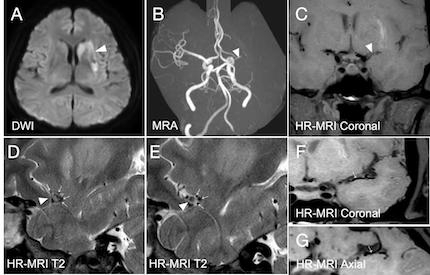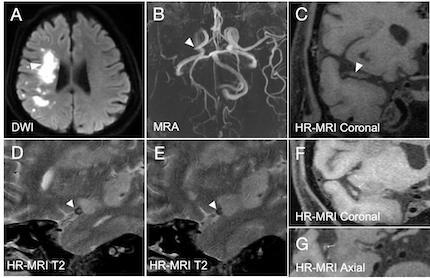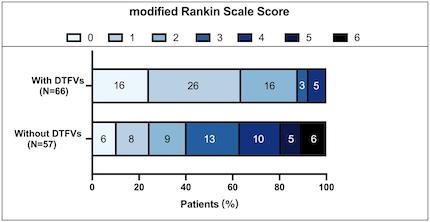Final ID: TP160
Deep tiny flow voids on high-resolution magnetic resonance imaging predict a favorable prognosis in patients with acute middle cerebral artery occlusion
Abstract Body: Background and purpose: Deep tiny flow voids (DTFVs) are a specific type of collaterals surrounding chronic steno-occlusive middle cerebral artery (MCA), which can be identified on high-resolution magnetic resonance imaging (HR-MRI). This study aimed to investigate the presence of DTFVs in patients with acute MCA occlusion and their relevance to clinical outcomes.
Methods: Using data from two multicenter cohort studies, we examined the presence of DTFVs in patients with acute MCA occlusion and analyzed their clinical and imaging characteristics. Univariable and multivariable logistic and linear regression analyses were conducted to assess the correlation between DTFVs and the 90-day modified Rankin Scale (mRS) scores. We further studied the mediating effect of residual flow distal to MCA occlusion on the relationship between DTFVs and 90-day mRS scores using mediation analysis.
Results: One hundred and twenty-three patients with acute MCA occlusion were included. The median age was 61 years (interquartile range [IQR], 51-67 years), and 73.73% of the patients were male. The median time from symptom onset to imaging was 44 hours (IQR, 25-67 hours). Sixty-six patients (53.66%) exhibited DTFVs on HR-MRI. Lower baseline NIHSS scores (4.5 [2-8] vs. 10 [4-14]) and smaller infarct volumes (5.76 [2.79-15.34] cm3 vs. 19.01 [7.16-83.59] cm3) were observed in patients with DTFVs compared to those without. Both multivariable logistic regression (odds ratio [OR]: 6.22, 95% confidence interval [CI]: 1.82 to 21.29, p = 0.004) and linear regression analysis (β: -0.60, 95% CI: -1.06 to -0.14, p = 0.012) indicated that patients with DTFVs exhibited better 90-day functional outcomes. The mediating effect analysis showed that the effect of DTFV on 90-day mRS scores was partially mediated by residual flow distal to MCA occlusion, with a proportion of 30.66% (95% CI: 8.97 to 69.29, p = 0.002).
Conclusions: In our study population, the presence of DTFVs was associated with a favorable outcome in patients with acute MCA occlusion, which may exert a protective effect partly by contributing to the formation of distal residual flow at the occlusion sites. Future studies are needed to investigate the potential of DTFVs in guiding individualized treatment strategies.
Methods: Using data from two multicenter cohort studies, we examined the presence of DTFVs in patients with acute MCA occlusion and analyzed their clinical and imaging characteristics. Univariable and multivariable logistic and linear regression analyses were conducted to assess the correlation between DTFVs and the 90-day modified Rankin Scale (mRS) scores. We further studied the mediating effect of residual flow distal to MCA occlusion on the relationship between DTFVs and 90-day mRS scores using mediation analysis.
Results: One hundred and twenty-three patients with acute MCA occlusion were included. The median age was 61 years (interquartile range [IQR], 51-67 years), and 73.73% of the patients were male. The median time from symptom onset to imaging was 44 hours (IQR, 25-67 hours). Sixty-six patients (53.66%) exhibited DTFVs on HR-MRI. Lower baseline NIHSS scores (4.5 [2-8] vs. 10 [4-14]) and smaller infarct volumes (5.76 [2.79-15.34] cm3 vs. 19.01 [7.16-83.59] cm3) were observed in patients with DTFVs compared to those without. Both multivariable logistic regression (odds ratio [OR]: 6.22, 95% confidence interval [CI]: 1.82 to 21.29, p = 0.004) and linear regression analysis (β: -0.60, 95% CI: -1.06 to -0.14, p = 0.012) indicated that patients with DTFVs exhibited better 90-day functional outcomes. The mediating effect analysis showed that the effect of DTFV on 90-day mRS scores was partially mediated by residual flow distal to MCA occlusion, with a proportion of 30.66% (95% CI: 8.97 to 69.29, p = 0.002).
Conclusions: In our study population, the presence of DTFVs was associated with a favorable outcome in patients with acute MCA occlusion, which may exert a protective effect partly by contributing to the formation of distal residual flow at the occlusion sites. Future studies are needed to investigate the potential of DTFVs in guiding individualized treatment strategies.
More abstracts on this topic:
A Multi-centre, Randomized, Controlled Study of External CounterPulsation for Patients with Recent Atherosclerotic Stroke (SPA)
Xiong Li, Chen Xiangyan, Leung Howan, Zhu Lixia, Leung Thomas, Wong Lawrence
A Comparison Between Global Longitudinal Strain (GLS) Derived with CMR Feature-Tracking (CMR-FT) and 2D Speckle-Tracking Echocardiography (2D-STE) to Monitor Cancer Therapy-Related Cardiac Dysfunction (CTRCD)Kar Julia, Cohen Michael, Revere Cherie, Mcquiston Samuel, Malozzi Christopher
Readers' Comments
We encourage you to enter the discussion by posting your comments and questions below.
Presenters will be notified of your post so that they can respond as appropriate.
This discussion platform is provided to foster engagement, and simulate conversation and knowledge sharing.
You have to be authorized to post a comment. Please, Login or Signup.
Rate this abstract
(Maximum characters: 500)



